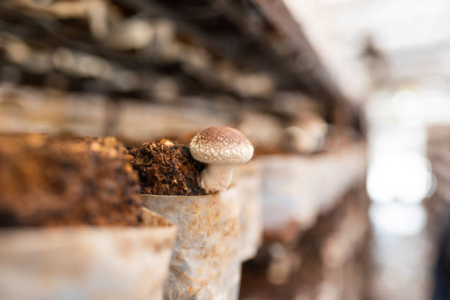Are you at risk? The shocking rental home discovery every Aussie needs to know about
By
Gian T
- Replies 0
When you think of mushrooms, you probably imagine them in a risotto or on your pizza, not sprouting from your lounge room floor! But for one Melbourne tradie, this fungal fright was all too real, and it’s a warning every Aussie—especially those of us who’ve seen a few winters—should take seriously.
Plumber Michael Schulze, who runs the leak detection company 1300FINDLEAK, was called out to a Brunswick rental property this week and made a discovery that would make anyone’s skin crawl: not one, but two clusters of mushrooms, each the size of his fist, thriving inside the home. And no, this wasn’t some quirky new interior design trend—these fungi were a glaring sign of a much bigger problem.
‘It was very, very wet. On a scale from 1 to 10, it was a 10 for sure,’ Michael told Yahoo News. ‘It’s not pleasant at all.’
So, what caused this mushroom mayhem? A long-ignored leak from the bath had allowed litres of stagnant water to pool beneath it, soaking into the walls and floors. Over time, the dampness spread, creating the perfect breeding ground for mushrooms and mould. The result? Toxic spores wafting through the air, putting the health of everyone in the home at risk.
Why should you care?
While the tenants in this case didn’t seem too bothered, Michael warns that many people simply don’t realise how dangerous living with damp and mould can be. ‘You can get really sick,’ he said. And he’s right—Health Victoria warns that inhaling mushroom spores can cause respiratory issues, allergic reactions, and even more serious symptoms like nausea, vomiting, and abdominal pain due to mycotoxin exposure.
Michael knows this from personal experience. Last year, he suffered from an ongoing illness until he discovered mould growing under his own bed. ‘I was just getting sick all the time,’ he recalled. It’s a sobering reminder that these issues can sneak up on anyone.
Spotting the signs before it’s too late
The good news? There are warning signs you can look out for before your home turns into a mushroom farm. Michael suggests keeping an eye out for bubbling or discoloured paint—these are often the first clues that water is building up where it shouldn’t be. If you spot mould (especially black mould), it’s a sign things have already reached crisis point.
And if you do find a leak, don’t just call any plumber—consider a leak detection specialist. ‘There’s a lot of people out there with leaks, but when people have them, they don’t seem to get a leak detector... They just call a plumber... But we look at leaks all day every day,’ Michael explained. The sooner you act, the better your chances of avoiding costly repairs and health problems.
Why is this happening more often?
With Australia’s wild weather—think relentless rain, storms, and humidity—dampness in homes is becoming more common. And it’s not just older properties at risk; even newer homes can fall victim if leaks go unnoticed. In fact, stories of mushrooms popping up in bedrooms and bathrooms are becoming alarmingly frequent. One Sydney mum even shared that her son thought aliens were invading after mushrooms appeared overnight!
Dr Tom May from the Royal Botanic Gardens Victoria has a simple message: ‘You definitely don’t want a mushroom inside your house releasing spores.’ If you spot one, it’s time to act fast.
What can you do to protect your home and health?
We’d love to hear your stories—whether it’s a horror story or a handy tip for keeping your home dry and healthy. Share your experiences in the comments below and help other members of the Seniors Discount Club stay safe this winter!

Remember, a little vigilance now can save you a world of trouble (and mushrooms) down the track. Stay dry, stay healthy, and keep those fungi where they belong—on your dinner plate, not your floor!
Plumber Michael Schulze, who runs the leak detection company 1300FINDLEAK, was called out to a Brunswick rental property this week and made a discovery that would make anyone’s skin crawl: not one, but two clusters of mushrooms, each the size of his fist, thriving inside the home. And no, this wasn’t some quirky new interior design trend—these fungi were a glaring sign of a much bigger problem.
‘It was very, very wet. On a scale from 1 to 10, it was a 10 for sure,’ Michael told Yahoo News. ‘It’s not pleasant at all.’
So, what caused this mushroom mayhem? A long-ignored leak from the bath had allowed litres of stagnant water to pool beneath it, soaking into the walls and floors. Over time, the dampness spread, creating the perfect breeding ground for mushrooms and mould. The result? Toxic spores wafting through the air, putting the health of everyone in the home at risk.
Why should you care?
While the tenants in this case didn’t seem too bothered, Michael warns that many people simply don’t realise how dangerous living with damp and mould can be. ‘You can get really sick,’ he said. And he’s right—Health Victoria warns that inhaling mushroom spores can cause respiratory issues, allergic reactions, and even more serious symptoms like nausea, vomiting, and abdominal pain due to mycotoxin exposure.
Michael knows this from personal experience. Last year, he suffered from an ongoing illness until he discovered mould growing under his own bed. ‘I was just getting sick all the time,’ he recalled. It’s a sobering reminder that these issues can sneak up on anyone.
Spotting the signs before it’s too late
The good news? There are warning signs you can look out for before your home turns into a mushroom farm. Michael suggests keeping an eye out for bubbling or discoloured paint—these are often the first clues that water is building up where it shouldn’t be. If you spot mould (especially black mould), it’s a sign things have already reached crisis point.
And if you do find a leak, don’t just call any plumber—consider a leak detection specialist. ‘There’s a lot of people out there with leaks, but when people have them, they don’t seem to get a leak detector... They just call a plumber... But we look at leaks all day every day,’ Michael explained. The sooner you act, the better your chances of avoiding costly repairs and health problems.
Why is this happening more often?
With Australia’s wild weather—think relentless rain, storms, and humidity—dampness in homes is becoming more common. And it’s not just older properties at risk; even newer homes can fall victim if leaks go unnoticed. In fact, stories of mushrooms popping up in bedrooms and bathrooms are becoming alarmingly frequent. One Sydney mum even shared that her son thought aliens were invading after mushrooms appeared overnight!
Dr Tom May from the Royal Botanic Gardens Victoria has a simple message: ‘You definitely don’t want a mushroom inside your house releasing spores.’ If you spot one, it’s time to act fast.
What can you do to protect your home and health?
- Inspect regularly: Check for signs of damp, especially after heavy rain or if you notice a musty smell.
- Ventilate: Open windows and use exhaust fans to keep air moving and reduce moisture.
- Fix leaks promptly: Don’t ignore that dripping tap or mysterious puddle—get it checked out by a professional.
- Clean up mould: Small patches can be cleaned with vinegar or specialised products, but large infestations may need expert help.
- Know your rights: If you’re renting, your landlord is responsible for maintaining the property. Don’t hesitate to report issues and request repairs.
We’d love to hear your stories—whether it’s a horror story or a handy tip for keeping your home dry and healthy. Share your experiences in the comments below and help other members of the Seniors Discount Club stay safe this winter!
Key Takeaways
- A Melbourne tradie discovered fist-sized clusters of mushrooms growing inside a rental property, caused by severe dampness from an unattended leak.
- The presence of mushrooms indoors indicates extreme moisture, which can lead to both structural damage and serious health risks due to toxic spores.
- Inhaling spores from mould and fungi can cause respiratory issues, allergic reactions, and even symptoms like nausea and abdominal pain.
- Early signs of water damage include bubbling or discoloured paint and mould growth—experts advise Aussies to address leaks promptly to avoid hazardous situations.








